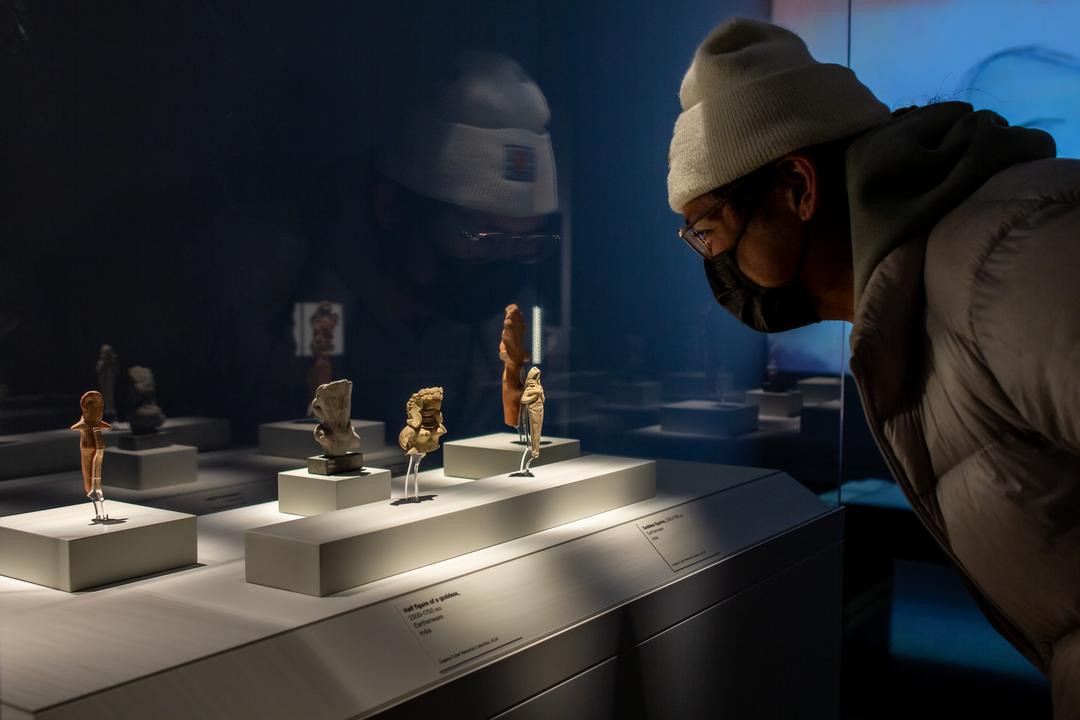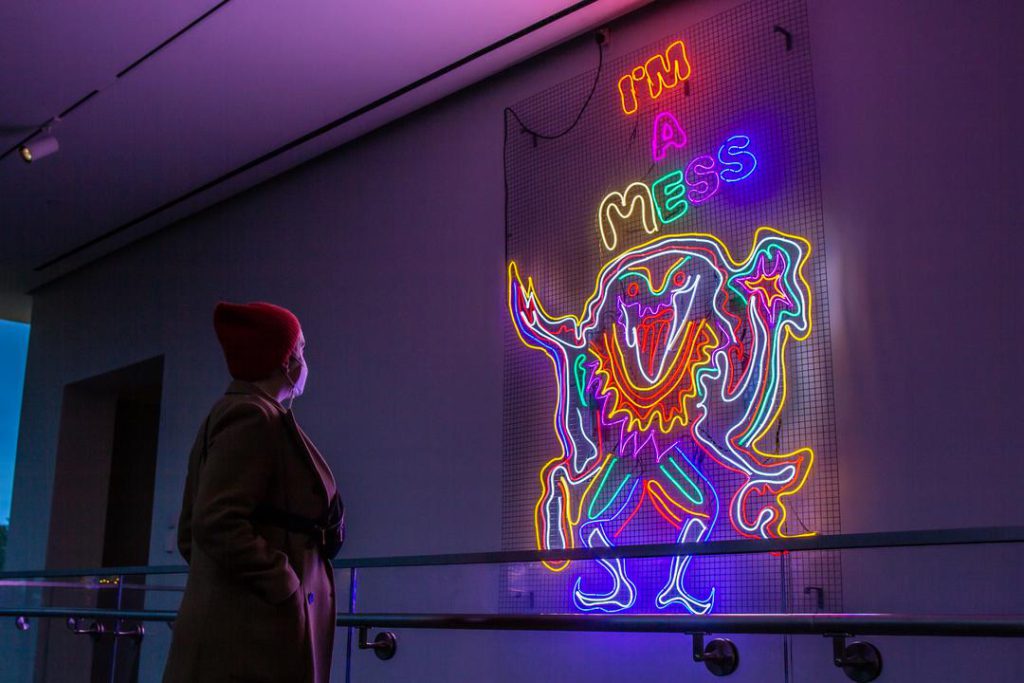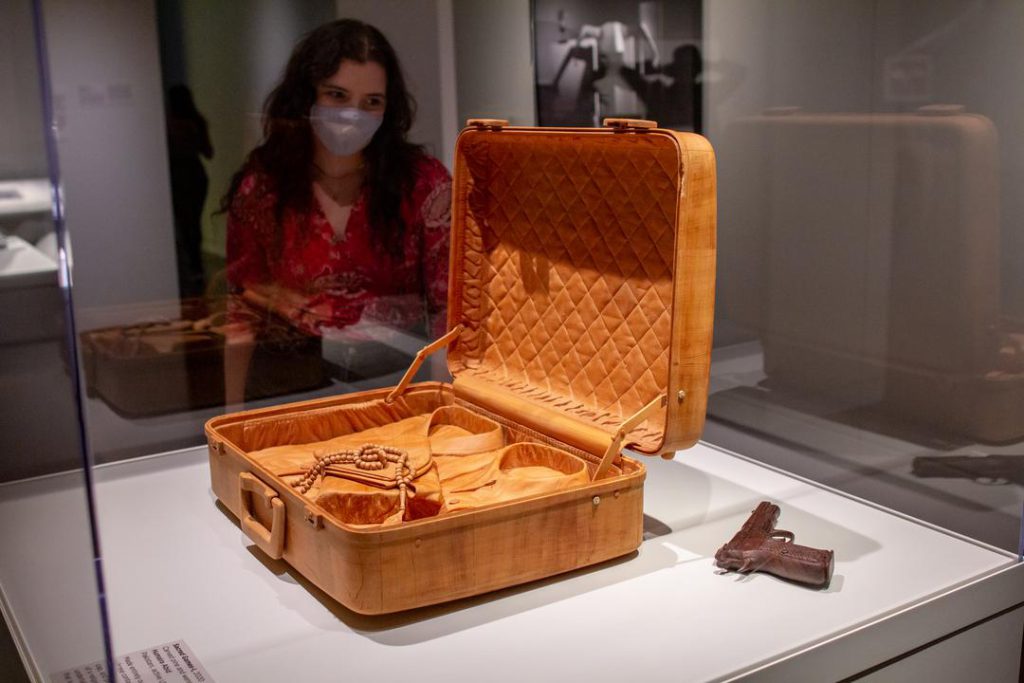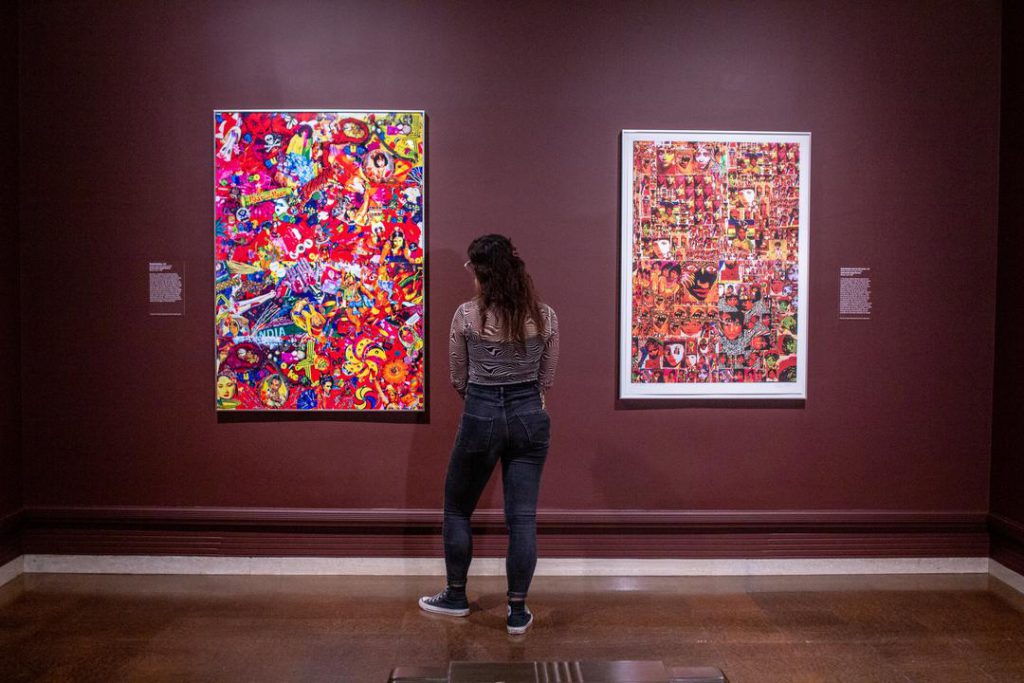#SAMSnippets: Embodied Change

Welcome back to #SAMSnippets! In this live series on our Instagram you get an up-close look at works in SAM’s permanent and semi-permanent installations. Each month, we choose a new gallery to walk through, offering you art appreciation wherever you may be!
In January, we featured a diverse collection of artworks from Embodied Change: South Asian Art Across Time. The first special exhibition to open in the remodeled and renovated Seattle Asian Art Museum, the featured works explore social, political, and religious perceptions of humanity and the human body through the lens of past and contemporary South Asian artists. Many of them utilize female and feminized forms in a myriad of ways, including as a devotional object, as a mode of self-representation, and to question the safety of public spaces. Watch the video now to get a peek at what’s on view at the Asian Art Museum now and learn more about the works shown below. Get your tickets now to see the entire exhibition before it closes on July 10!
The tour begins with a look at Chila Kumari Singh Burman’s Kali (I’m a Mess). For more than 30 years, Burman has used a variety of mixed media to advocate for female empowerment, racial equity, and her Punjabi heritage. Kali (I’m a Mess) was a part of Burman’s recent installation titled Remembering A Brave New World, superimposed over the Tate Britain’s entrance. Perched atop the building’s pediment, the Hindu goddess of destruction and protection obfuscated the statue of Britannia. The text above Kali reads, “I’m a Mess,” a message usually not associated with Kali. Burman takes Kali seriously as a potent symbol of liberation and rebellion and uses this text to speak to political and social concerns that occurred in 2020. Kali (I’m a Mess) is one of a few works in Embodied Change which was acquired into SAM’s permanent collection as a result of being included in this exhibition.
As we enter the exhibition, the camera pans across five earthenware and clay terracotta figures. Originating from the Indus Valley civilization in modern day India, Pakistan, and Afghanistan, these works date back to 2600–1900 BCE. Archaeological digs in the area have revealed numerous small, female figures, usually sculpted with wide hips, small breasts, stocky appendages, and abundant jewelry. Early scholars deified these figures as “mother goddesses” (a manifestation of Devi), creating a tie between past religious beliefs and present-day Hindu practitioners. This interpretation has been reevaluated, questioning whether these items were truly representative of religiosity. Their meaning remains a mystery but the near absence of male figures suggest the body held significant importance.
Next, we see two photographs by Brendan Fernandes: As One III and As One IX. Fernandes is Canadian of Kenyan and Goan (South Asian) descent, and his last name evokes the complex circuits of exchanges between the Portuguese colonial apparatus and western India. In his work, Fernandes is invested in bodies that move, showing that the human body has a range of permutations, meanings, and identities. The artist and his practices does not hold a fixed identity or a singular idea of Europe, Africa, or India. Overall, he envisions “a different process of communication,” one that is body-driven.
These two photographs were created locally. Fernandes used dancers from the Pacific Northwest Ballet in the auditorium of the Seattle Art Museum alongside African masks from SAM’s permanent collection. Using gestures derived from classical French ballet, the two dancers address the African masks with formality and etiquette. Compositionally, the dancers’ heads are hidden, which allows for the masks to stand in for the dancers’ missing faces. Through such juxtapositions, Fernandes forges a bridge between the inanimate and the animate.
Adeela Suleman’s Helmet is part of a series repurposing kitchen objects. Made from utensils including a colander and tiffin (lunch box), the form is gendered as it uses objects typically located in the interior space of the kitchen, often associated with female domesticity. In performance photographs, Suleman dons these helmets, suggesting that women need special armor in their day-to-day movement in the public arena. The rigid and hard helmets provide little real protection. One wonders how much protection Suleman wants her pieces to afford; she seems to gesture to the futility of such an attempt.
In a glass pedestal adjacent to Suleman’s Helmet, we see Humaira Abid’s Sacred Games-I. Made entirely out of wood, the open suitcase contains clothes, a holy book, a cap, and prayer beads, all the possessions of a religious practitioner who is undertaking a spiritual journey. The gun that is placed alongside the belongings symbolizes both religious extremism and violence toward religion, including attacks on mosques, churches, and other religious buildings. In the artists’s own words, “all societies have extremists who twist religion as well as other social institutions and use it to their own benefit, to oppress women and vulnerable and defenseless people.”
The final section of the video is focused on portraits. Here, the featured artists use the theme of portraiture to challenge bodily ideals and the role of the female body in the arts.
The first portrait we see is B. Prabha’s Untitled. Active in the 1960s when there were few professional female artists, her trademark was elongated figures of rural women with a subdued color palette. Hailing from the small Indian village of Bela, near Nagpur, India, Prabha gravitated to rural village scenes. She painted lower caste women at work and at leisure. In this portrait, the unknown woman rests her back against a tree as she enjoys the company of a bird. Although Prabha typically depicted the silent labor of rural women to show their plight and suffering, she also endeavored to give them grace and personhood by depicting them enjoying moments of rest.
The camera next pans two works by Chila Kumari Singh Burman: Auto-Portrait, from Fly Girl series and Punjabi Rockers. In this first large collage work, Burman distorts her portrait through a range of different guises and manipulations. Her face is stretched, magnified, compressed, and painted with bright colors. Through the act of repetition and the reproduction of the print form, Burman crafts new personas, enacting fantasies of the self as the goddess Kali and as pop icons. As Burman explains, “These self portraits position the construction of racial and sexual identity as a process that is crafted and fluid within the process of representation. My manipulation of the photographic image questions the idea of the photograph as a document of the empirical reality to reveal ‘an image of myself.'” In other words, Burman resists a singular identity. Through the act of printmaking, she can reconstruct multivalent identities for herself.
In Punjabi Rockers, Burman, a member of the British Black Arts Movement, mines both South Asian histories and pop culture to overwhelm and challenge Euro-American perceptions of South Asian women. She has declared, “My work is about reclaiming the image of Asian women, moving away from the object of the defining gaze, toward a position where I, [an] Asian woman, become the subject of display. My self-portraits construct a femininity that resists the racist stereotype of the passive, exotic Asian woman, imprisoned by male patriarchal culture.” Together, these two prints burst forth with levity and joy to convey Burman’s political message of empowerment.
We then see Rekha Rodwittiya’s Untitled. Consistently, Rodwittiya paints female figures with vibrant, bold colors. The scale of her portraits tends to be quite monumental to celebrate the female form. Even in such large compositions, a sense of intimacy is present. In this canvas, a local schoolgirl shows off her spinning top. With her content smile, she is both anonymous and knowable. Regarding her practice, Rodwittiya states, “I live and breathe as a feminist so therefore that is the prism through which I perceive everything around me, and so therefore it would patina my art as well.”
The final work in the video is Mithu Sen’s Miss Macho (Self Portrait), from the False Friends series. Sen paints a mustache on her self-portrait along with overgrown floral vines in her hair and a phallic building on the bridge of her nose. Consistently throughout her practice, Sen applies a confrontational approach to topics related to the body, including sex. This work is part of the series called False Friends, in which Sen asked strangers to take photographs of her. According to Sen, during her childhood, she was considered the “literal black sheep” of her family since she was visibly darker-skinned than her light-skinned female family members. Here, Sen’s face occupies the entire canvas, making space for herself in her social and professional world. Her gaze is both otherworldly and visceral.
– Lily Hansen, SAM Marketing Content Creator
Video Artworks: Kali (I’m a Mess), Chila Kumari Singh Burman, 2020, 6mm 12v silicone LED neon, galvanized weld mesh, 12v switch mode transformers, IP67 plastic box, 137 13/16 x 70 7/8 × 1 3/16 in. (180 × 35 × 3 cm), Richard E. Lang and Jane Lang Davis Acquisition Fund for Global and Contemporary Art, 2021.25. Goddess Figurine, India, Earthenware, 2300–1750 BCE, Earthenware, 4 3/8 x 1 3/4 x 11/16 in. (11.11 x 4.45 x 1.75 cm), Eugene Fuller Memorial Collection, 41.23. Half Figure of a Goddess, India, Earthenware, 2300–1750 BCE, Earthenware, 2 3/4 x 3 x 1 in. (6.99 x 7.62 x 2.54 cm), Eugene Fuller Memorial Collection, 41.24. Fragmentary Figure, India, Terracotta, ca. 3rd millennium BCE–2nd century CE, Terracotta, 7 1/2 x 2 5/8 x 2 in. (19.05 x 6.67 x 5.08 cm), Gift in honor of Millard B. Rogers, 93.31. Fragmentary Figure, India, Terracotta, ca. 2nd–1st century BCE, Terracotta, 3 7/8 x 2 1/2 x 1 1/2 in. (9.84 x 6.35 x 3.81 cm) Overall h.: 4 3/4 in. Overall w.: 2 3/4 in., Eugene Fuller Memorial Collection, 39.36. Fragmentary Figure, India, Terracotta, ca. 3rd millennium BCE–2nd century CE, Terracotta, 4 1/8 x 1 3/4 x 3/4 in. (10.48 x 4.45 x 1.91 cm), Gift in honor of Millard B. Rogers, 93.32. As One III, Brendan Fernandes, 2017, Digital print, 34 x 48 in., Gift of Christopher and Alida Latham, 2019.27.1. As One IX, Brendan Fernandes, 2017, Digital print, 34 x 48 in., Gift of Christopher and Alida Latham, 2019.27.2. Helmet, Adeela Suleman, 2008, Metal with foam and cloth, Collection of Sanjay Parthasarathy and Malini Balakrishnan. Sacred Games-1, Humaira Abid, 2020, Carved pine and wenge woods, Collection of Christopher and Alida Lantham. Untitled, B. Prabha, ca. 1960s, Oil on canvas, Collection ofSanjay Parthasarathy and Malini Balakrishnan. Auto-Portrait, from Fly Girl series, Chila Kumari Singh Burman, 1993, Mixed media and laser printer,Collection ofSanjay Parthasarathy and Malini Balakrishnan. Punjabi Rockers, Chila Kumari Singh Burman, 1993, Mixed media and laser printer,Collection ofSanjay Parthasarathy and Malini Balakrishnan. Untitled, Rekha Rodwittiya, ca. 1990s, Acrylic and oil on canvas,Collection ofSanjay Parthasarathy and Malini Balakrishnan. Miss Macho (Self Portrait), from the False Friends series, Mithu Sen, 2007, Mixed media photocollage on archival paper,Collection ofSanjay Parthasarathy and Malini Balakrishnan.


